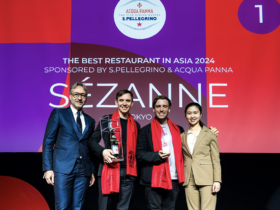Recently recognized as the 5th taste, umami is now the hottest taste for almost everything including sake. Sake Master Shata-san explains how that’s been done for centuries.
About 5 years ago, western scientists confirmed a completely new taste – Umami. Interestingly enough, Japan and the rest of Asia have recognized the Umami taste all along. And we’ve have been perfecting it in foods ranging from soya sauce to sake for centuries.
Back in the day
During the time Sir Stamford Raffles established Singapore (hint: year 1819), a little shop in Ishikawa prefecture, Japan, started brewing its first batch of sake.
The prefecture is well-known for its history of outstanding craftsmanship, culture and sophistication which rivalled the old capital, Kyoto. It should be no surprise that some of the finest sake distilleries come from this area. And Shata Brewery is one of them.
8 Generations of Sake brewers
In a recent sake tasting, I had the pleasure to meet the Kazunari Shata, the 8th generation descendant of the brewery’s founder. Formerly banker, he returned to his family’s business to helm it growth. As part of Shata’s expansion into Singapore, he is introducing 4 selected expressions of their Tengumai sake – Junmai Umajun, Yamahai Jikomi Junmai, Junmai Daiginjo 50, and Yamahai Junmai Daiginjo. The first three are medallist winners in the Los Angeles International Wine Competition 2014.
As with any artisans, Shata-san was fond of describing the intricacies of their craft. He described in depth the special rice they used, the polish technique the rice received, the koji (enzyme) used for brewing, and how the art has transformed through the ages.
In the course of modernization, the sake process moved from aging in wooden casks to stainless steel. And to ramp up productivity, lactic acid was added to speed the fermentation process which resulted in a slight loss of taste and body.
Keeping it authentic with Yamahai
True to their art, Shata Brewery also produces sake with the traditional “Yamahai” method. By leaving the rice ferment a little bit longer and warmer, without the addition of lactic acid, the Yamahai process achieves a fuller and stronger umami taste from the rice.
Upon side-by-side comparisons, the Tengumai Yamahai Jikomi Jumai and Tengumai Yamahai Junmai Daiginjo produced fuller flavour and richer aftertaste compared to the other two variants.
Though both sakes used the Yamahai process, the former had a stronger drier taste suitably paired for more savoury, richer meat dishes; while the latter was more elegant and slightly sweeter, suitable for delicate dishes such as sushi or sashimi.
Since I ordered Matsu-ni, a traditional thick-gravied beef offal stew, during this tasting, it’s no surprise that I preferred the stronger, bolder, and fuller taste of the Tengumai Yamahai Jiko Jumai to match.
Overall, the Tengumai Sakes were very smooth, tasty and exceptionally refined. You’d expect that from artisans who’ve been perfecting the craft for hundreds of years. We have to thank people like Kazunari-San for carrying the tradition for all of us to enjoy.
By Frank Young
A special thanks to Sake Master Kazunari-San for my first introduction to sake making and the opportunity to appreciate their internationally award-winning Tengumai Sakes.
Tengumai is available at many fine Japanese restaurants including The Public Izakaya (1 & 2) and retailers such as 1855 Bottle shop and Enoteca Wine Shop.
ADVERTISEMENTS














Leave a Reply